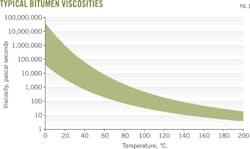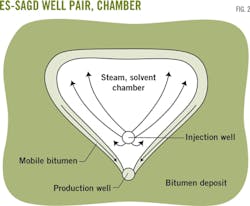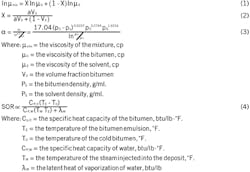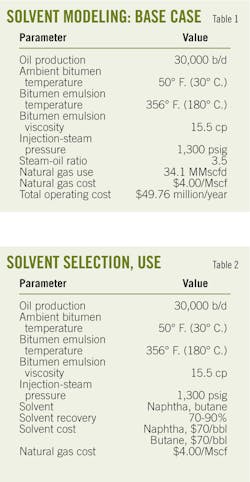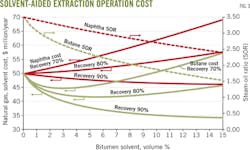Modeling determines solvent applicability in SAGD
View Image Gallery>>
Justin Boudreau
AECOM Technology
Chelmsford, Mass.
Solvents are used to increase production and reduce steam-to-oil ratio in steam-assisted gravity drainage (SAGD). Variations of SAGD that use solvents, such as expanding solvent (ES) SAGD or solvent-aided process (SAP), have sparked academic and commercial interest with several pilot projects currently in operation in Canada and the US.
Selecting an optimal solvent and determining the associated economics, however, can be difficult. This article discusses how a simple model can be used when examining the applicability of solvents in SAGD.
Reducing bitumen viscosity
Canadian oil sands have proved reserves of 167.9 billion bbl, but only about 20% of this reserve is accessible by surface mining. The remaining 80%, about 134 million bbl, requires in situ methods, such as SAGD, to extract the bitumen. In 2012, bitumen extraction from SAGD exceeded surface mining for the first time.1
SAGD addresses one of the most difficult problems in extracting bitumen: high viscosity. At ambient temperature (68 °F. or 20 °C.), the viscosity of bitumen can exceed 1 million cp, making it more a solid than a liquid (Fig. 1).
Extracting the bitumen requires reducing its viscosity. In SAGD, two horizontal wells are drilled into the bitumen deposit. The wells run parallel, with one well 13-20 ft (4-6 m) above the other.
High-pressure steam (1,000-1,600 psig) is injected into the top injection well. The steam heats the surrounding bitumen and reduces its viscosity to the point where it can flow through the bottom producing well to the surface.
The emulsion of bitumen and condensate recovered from the producing well is destabilized with emulsion breakers. Diluent is added and the bitumen-diluent mixture is separated from the condensate. The recovered condensate (produced water) is treated and used as boiler feed water to produce more high-pressure steam for injection into the deposit.
There are several drawbacks to SAGD. One is the resources needed to extract the bitumen. For every barrel of bitumen, about 3-5 bbl of water are needed for steam. The dissolved solids and oil in the condensate, even after treatment, makes conventional high-pressure drum boilers unusable.
Once-through steam generators (OTSGs), which produce a lower quality steam (about 70-80% vapor), are used instead. OTSGs use natural gas as a heating source. Due to their design, less expensive options, such as coal or bitumen, won't work. The natural gas used for the OTSGs represents a major operating cost and a source of potential greenhouse-gas emissions.
Mitigating SAGD drawbacks
To mitigate the drawbacks of conventional SAGD, a solvent can be added to the well with the steam. The steam and solvent are transported to the edge of the surrounding bitumen. The steam condenses and transfers its latent heat to the bitumen, heating it and reducing its viscosity (Fig. 2).
The solvent further dissolves the bitumen, reducing its viscosity and decreasing the steam-to-oil ratio (SOR). Less steam is needed per barrel of oil extracted. This means less natural gas is needed to create the steam, reducing greenhouse emissions.
There have been several pilot steam-solvent hybrid SAGD projects. Most notable have been the EnCana Corp. (now Cenovus Energy Inc.) pilots at Senlac in 2002 (OGJ Online, Mar. 14, 2001) and Christina Lake in 2004 (OGJ Online, Apr. 12, 2004).
Both pilots used butane as a solvent and saw an increase in oil rate (50% for Senlac and 150% for Christina Lake) and a reduction in SOR.
In addition to butane, other solvents have been proposed including naphtha and methane. The ideal solvent should be low-cost, low viscosity, noncorrosive, and shopuld have a high recovery rate in the formation. It should also posses these properties:
• Condenses similarly to steam.
• Disolves bitumen readily.
• Increases oil production and reduces steam use.
• Is recovered easily and inexpensively from the bitumen emulsion on the surface.
• Is handled easily and safely.
After a solvent is selected, how much solvent to use becomes the question. Much like selecting a solvent, the amount used is largely dictated by economics. If too little is used, there will be little improvement in oil production and steam use. If too much is used and not recovered, solvent costs could negate steam savings and increased oil production.
View Image Gallery>>
Modeling solvent economics
Although there are many factors that influence oil-production rates and SOR (such as reservoir permeability and porosity, reservoir height, and thermal diffusivity), the effects of a solvent can be simplified through use of a differential model.
These models assume that reservoir conditions remain the same for the modeled case as for the base case. The addition of solvent is assumed only to reduce the viscosity of the bitumen. This reduction in viscosity can be quantified with the Lederer equation and with a relation proposed by W. Shu (Equations 1-3).2
Combining Equations 1, 2, and 3 makes it possible to solve for the viscosity of the solvent-bitumen mixture by using the densities and viscosities of pure bitumen and solvent.
The SOR is estimated with a simplified energy balance and is assumed to vary proportionally with the ratio of the change in bitumen enthalpy to the change in steam enthalpy (Equation 4).
A case in which no solvent is used provides a baseline for the model. Solvent can then be added and the steam -injection rate reduced to maintain the same bitumen viscosity; providing an equal comparison between cases. Table 1 shows the inputs to a hypothetical base case.
Other solvent models
Other scenarios can be developed from this base case. For example, naphtha or butane can be added as solvents. Because not all the solvent is recovered with these, there is added cost to the operator. When determining which solvent and the amount of solvent to use, operators need to look at the cost of solvent, how much of it can be recovered, and natural gas prices (Table 2, Fig. 3).
For both naphtha and butane, as the concentration of the solvent increases, the SOR decreases. Butane reduces the viscosity of the bitumen more dramatically than naphtha, especially at lower concentrations. This translates into a lower SOR and greater cost savings.
For naphtha, the economics only start to favor solvent addition with a recovery of 85-90%. For butane, the largest cost savings are found at certain volume percentages in bitumen.
For example, with an 80% recovery, about 5-6% volume to volume (v/v) butane in the recovered bitumen delivers $8.2 million/year in savings compared with conventional SAGD. Concentrations lower and higher than 5-6% result in lower savings. With higher recoveries, there is less makeup solvent, making higher solvent concentrations more economical.
The inverse is true for lower recoveries. With a 70% recovery, the optimal amount of butane is only about 3% v/v and only brings savings of $5.1 million/year.
Prices for natural gas and solvent were assumed to be $4.00/Mscf and $70/bbl of butane or naphtha. The prices of natural gas and solvent are quite variable and can sharply affect the economics. A reduction in the price of natural gas or an increase in the price of solvent will tend to favor conventional SAGD, while the inverse will favor the addition of solvent.
View Image Gallery>>
Fig. 4 shows the spot price for natural gas (US Gulf Coast). Prices have peaked higher than $13/Mscf and have been as low as $2/Mscf.3 In recent years, the price of natural gas has been about $2-6/Mscf. Additional model cases for butane solvent were developed with $2/Mscf, $3/Mscf, $4/Mscf, $5/Mscf, and $6/Mscf.
For all these cases, a solvent recovery of 80% was assumed. All other parameters are the same as the previous cases. Yearly operating costs increase with higher natural gas prices, but savings from using butane solvent also increase. Fig. 5 shows the optimum operating points with different natural gas prices.
Additional costs
This analysis accounts for natural gas and solvent costs, but there are also capital costs associated with solvent recovery.
Such analysis is outside the scope of this article but should be considered when comparing the overall costs of SAGD and hybrid solvent-steam extraction. Capital costs can have a considerable impact on the decision to modify a SAGD plant to use hybrid solvent-steam injection.
For example, butane delivers larger cost savings because it better reduces viscosity. Using butane, however, means installing new equipment to recover the butane solvent from the produced bitumen.
Since many SAGD operations use naphtha as a diluent to transport bitumen via pipeline, there are already naphtha-recovery operations. By using naphtha as a solvent, these existing unit operations can be used to recover the solvent, reducing capital costs.
References
1. Energy Resources Conservation Board, "Alberta's Energy Reserves 2012 and Supply/Demand Outlook 2013-22," ST98-2013, May 2013.
2. Shu, W., "A Viscosity Correlation for Mixtures of Heavy Oil, Bitumen, and Petroleum Fractions," SPE, 1982.
3. US Energy Information Administration, "Henry Hub Gulf Coast Natural Gas Spot Price," Dec. 2011.
The author
Justin Boudreau ([email protected]) is a process engineer for AECOM. His areas of focus are refining and upgrading projects, including options evaluation and detailed engineering design. Boudreau holds a BS in chemical engineering from Worcester Polytechnic Institute, Mass.

